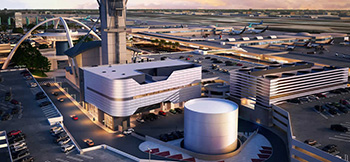 LOS ANGELES — A replacement central utility plant (CUP) at Los Angeles International Airport (LAX) completed last month is considered the first sustainable utility plant at a U.S. airport.
LOS ANGELES — A replacement central utility plant (CUP) at Los Angeles International Airport (LAX) completed last month is considered the first sustainable utility plant at a U.S. airport.
Los Angeles Councilmember Mike Bonin and Board of Airport Commissioners Vice President Valeria Velasco joined airport officials on April 23 for a ribbon-cutting ceremony to commemorate the completion of the new CUP.
The $423 million, 75,000-square-foot CUP improves heating and cooling of airline terminals and other buildings in LAX’s Central Terminal Area, or CTA. The four-year project to build the CUP will save LAX about $7 million annually in electrical and natural gas use. Pollution-control equipment also reduces carbon dioxide emissions. The facility produces its own electricity for its operations, which will result in an estimated $2 million in rebates from the Los Angeles Department of Water and Power. The CUP is expected to achieve LEED Gold certification from the U.S. Green Building Council (USGBC) and will be about 25 percent more energy efficient than the former facility.
Arup, headquartered in London, served as the engineer-of-note for the CUP. Other project team members included Clark/McCarthy, a joint venture of Clark Construction of Bethesda, Md., and McCarthy Building Companies of San Diego. Gruen Associates of Los Angeles served as the architect. The project team also worked with Greenform of Los Angeles to consult on sustainability features.
The new CUP consists of three main architectural elements: a four-story building that contains the plant and staff offices; an above-ground, cylindrical 1.5 million-gallon thermal energy storage tank that rises nearly four stories; and a maintenance facility with workshops on the ground floor and cooling towers above. The CUP services the recently renovated and expanded Tom Bradley International Terminal (which recently earned LEED Gold certification), the remaining eight terminals, the Theme Building and the East Administration Building.
Behind the metal and glass facade of the new CUP is 20,000 tons of cooling capacity to supply all nine LAX terminals. A plant that includes electric-driven centrifugal chillers, heat recovery boilers, primary and secondary chilled water pumps, cooling towers and thermal energy storage delivers the cooling capacity. An 8.4-megawatt cogeneration plant consists of gas-turbine-driven generators to provide electricity and the waste heat will be reused for heating and to power additional steam-driven chillers.
“We knew from the start we selected the right project team for this project. We were able to keep the airport operating with minimal interruption to our traffic flow and will save money on both capital and operating costs. It doesn’t get any better than that as an owner/operator," said Gina Marie Lindsey, executive director of Los Angeles World Airports (LAWA), in a statement. "Arup and the rest of the design/build team were able to deliver an innovative and cost-effective solution under budget. We were very impressed with how they approached and collaborated on problems and found solutions in order to keep the work moving forward so as not to impact our project schedule."

